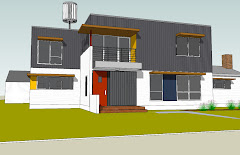 . Looking up from the kitchen to the second floor "bridge".
. Looking up from the kitchen to the second floor "bridge".This week and last has seen a dramatic change to the interior of our house. The gypsum board (aka sheetrock) has gone up and we now have defined rooms. Now that we are not able to see from space to space (at the upper floor) we are getting used to the final sizes of the rooms. Some of the bedrooms are quite small, but we’re reminding ourselves that that was intentional and kids don’t really need double beds anyway, right?
 In Mazzy's bedroom, looking to her closet.
In Mazzy's bedroom, looking to her closet.Gypsum board has been the industry standard for about 50 years. By 1955, an estimated 50 percent of new homes were built using gypsum wallboard; the other 50 percent with built with gypsum lath and plaster. Gypsum board, or drywall, is typically made with 100% recycled, unbleached paper facings that are bonded without adhesives onto a gypsum core. Though mined virgin gypsum is still widely used in gypsum board production, recycled and synthetic gypsum comprise an increasing portion of product manufacturing. Another potential issue with gypsum board is mold growth in conditions of high humidity and low air circulation.
There are some options to gypsum board are out there. Magnesium oxide board “MgO board” does not have the paper face, thus will not promote mold growth. It’s extremely hard, but can’t be easily scored and snapped like gypsum board. One MgO board is called “Dragonboard”. http://www.dragonboard.com/ They make the dramatic claim that “No energy is consumed in manufacturing DRAGONBOARD.” That statement is simply untrue. Everything takes energy to produce. The manufacturing process takes place at room temperature which is great, but exactly how they can get by without consuming energy? There are lights on in the building, machinery involved in the extractions, manufacture and shipping. Energy is used.
Green E-board http://www.greeneboard.com/ is another MgO board that is marketed by Southern Cross Technologies in Florida. Don’t be fooled by the USGBC’s logo on the front of the web page however. The USGBC doesn’t approve or certify products. It's unclear where the product is made, but it doesn't appear to be local to us.
Most of the MgO board comes from overseas (mainly Asia) at this point. Which translates into significant embodied energy in its production (coal burning energy sources) and transportation and does not benefit the local economy. If this were to change, with more plants available across the country, MgO board might become a more viable green alternative. As for now, it’s hard to compete with gypsum board that has manufacturing plants regionally.
We are using dens gold gypsum board (no paper - fiberglass faced) at all bathroom and potentially damp areas. (We’re using cement board behind tiled areas such as the tub and shower.) Everywhere else, we are using 5/8” FX (fire resistive) gypsum board on both walls and ceilings. Standard thickness is ½” (and sometimes even 3/8”) in residential construction but we went thicker for better stability. And yes, the extra 1/8” thickness means we’re using a bit more material resources than typical, but the gypsum board we’ve got from USG contains a minimum of 25-45% recycled content and it comes from a few miles away.

In kitchen with island kneewall to the left. Looking towards door to basement.

South and west windows in the kitchen.


Living rooms window on left with view to backyard. Opening to mudroom/back entry on right.


4 comments:
Who's the dude riding the bike in your schematic?
This is great. However, Kevin's missed what the public is really clamoring for...a "King Rex and the Fish Stompers" reunion AND midwest tour....
Oh - nobody really wants to see me try to fit into those leopard skin pants again!
-K
This article focuses on the correct usage of the Gypsum Boards.
Gypsum boards are widely used.
"MgO"board does not have the paper face but it will not promote the mold growth. It's extremely hard but cannot be easily scored and snapped like Gypsum board.
At Last, Gypsum board should be utilize properly.
Name : Chloe The Double Beds Expert
Email: doublebeds@gmail.com
URL: http://www.lirmarketing.ie/bed_range/life_style_living.htm
Post a Comment